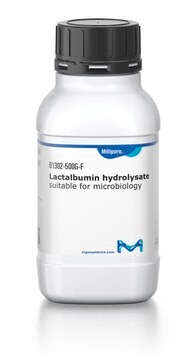S9895
Schneider′s Insect Medium
With L-glutamine, without calcium chloride and sodium bicarbonate, powder, suitable for insect cell culture
Sinónimos:
Schneider’s Drosophila Medium
About This Item
Productos recomendados
Nivel de calidad
formulario
powder
concentración
24.5 g/L
técnicas
cell culture | insect: suitable
componentes
glucose: 2 g/L (Dextro)
NaHCO3: no
L-glutamine: 1.8 g/L
Condiciones de envío
ambient
temp. de almacenamiento
2-8°C
¿Está buscando productos similares? Visita Guía de comparación de productos
Descripción general
Aplicación
SCHNEIDER′S INSECT MEDIUM is one of the cell culture media available from Sigma. The selection of a nutrient medium is strongly influenced by 1] type of cell, 2] type of culture [monolayer, suspension, clonal] and 3] ° of chemical definition necessary. It is important to review the literature for recommendations concerning medium, supplementation and physiological parameters required for a specific cell line.
Nota de preparación
Supplements can be added prior to filtration or introduced aseptically to sterile medium. The nature of the supplement may affect storage conditions and shelf life of the medium.
1.Measure out 80% of final required volume of water. Water temperature should be 15-20 °C.
2.While gently stirring the water, add the powdered medium. Stir until dispersed. Material will not go in solution completely. Do NOT heat water.
3.Rinse original package with a small amount of water to remove all traces of powder. Add to solution in step 2.
4.To the solution in step 3, add 0.4 g sodium bicarbonate or 5.3 ml of sodium bicarbonate solution [7.5% w/v] for each liter of final volume of medium being prepared. Stir until dissolved.
5.While stirring, adjust the pH to at least 9.2 ± 0.2 with sodium hydroxide. Stir for a minimum of 10 minutes. Solution may become turbid.
6.While stirring, adjust the pH to 6.7 ± 0.2 with HCl, solution will clear.
7.Prepare a calcium chloride solution by dissolving 0.6 g of anhydrous calcium chloride [C5670] in 50 ml of tissue culture grade water for EACH liter of final volume of medium being prepared. Slowly add the calcium chloride solution dropwise to the medium with rapid mixing to avoid precipitate formation.
8.While stirring, adjust the pH of the medium to 0.1-0.3 pH units below the desired pH since it may rise during filtration. The use of 1N HCl or 1N NaOH is recommended.
9.Add additional water to bring the solution to final volume.
10.An osmotic pressure of 360 mOsm ± 5% is suitable for the growth of cells derived from Drosophila melanogaster. If desired the osmotic pressure can be increased 10 mOsm by adding potassium chloride (0.4 g salt OR 2 ml of a 20% (w/v) solution) OR sodium chloride (0.3 g of salt OR 2 ml of a 15% (w/v) solution) for EACH liter of final volume of medium being prepared. The osmotic pressure can be decreased 10 mOsm by adding 27.8 ml of water for EACH liter of final volume of medium being prepared. Stir until dissolved.
11.Sterilize immediately by filtration using a membrane with a porosity of 0.22 microns or less.
12.Aseptically dispense medium into sterile container.
Para utilizar con
suplemento
también adquirido normalmente con este producto
Palabra de señalización
Danger
Frases de peligro
Consejos de prudencia
Clasificaciones de peligro
Eye Dam. 1
Código de clase de almacenamiento
11 - Combustible Solids
Clase de riesgo para el agua (WGK)
WGK 3
Certificados de análisis (COA)
Busque Certificados de análisis (COA) introduciendo el número de lote del producto. Los números de lote se encuentran en la etiqueta del producto después de las palabras «Lot» o «Batch»
¿Ya tiene este producto?
Encuentre la documentación para los productos que ha comprado recientemente en la Biblioteca de documentos.
Los clientes también vieron
Nuestro equipo de científicos tiene experiencia en todas las áreas de investigación: Ciencias de la vida, Ciencia de los materiales, Síntesis química, Cromatografía, Analítica y muchas otras.
Póngase en contacto con el Servicio técnico







